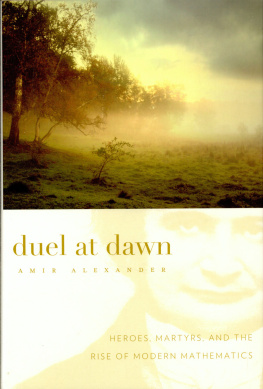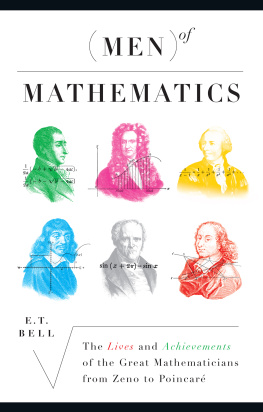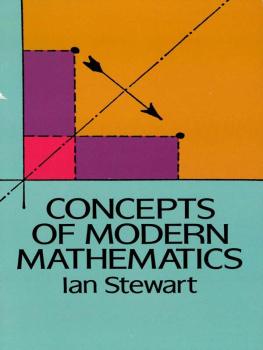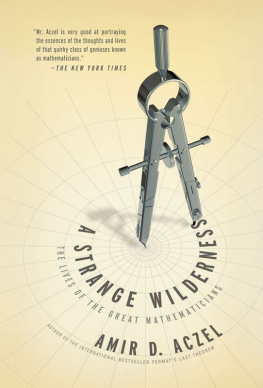
DUEL AT DAWN
HEROES, MARTYRS, AND THE RISE OF MODERN MATHEMATICS
Amir Alexander
HARVARD UNIVERSITY PRESS
Cambridge, Massachusetts
London, England
2010
Copyright 2010 by the President and Fellows of Harvard College
Library of Congress Cataloging-in-Publication Data
Alexander, Amir.
Duel at dawn : heroes, martyrs, and the rise of modern mathematics I Amir Alexander.
p. em.
Includes bibliographical references and index.
ISBN 978-0-674-04661-0 (alk. paper)
1. Mathematics-Social aspects-History. I. Title.
QA10.7.A44 2010
510.9-dc22 2009043776
To Bonnie
Beauty is truth, truth beauty,that is all
Ye know on earth, and all ye need to know.
John Keats
Contents
Introduction:
A Showdown in Paris
In the early dawn of May 30, 1832, in the southern Paris suburb of Gentilly, two young men faced each other with pistols drawn. The identity of one of the men has been lost to us, although he may have been Pescheux dHerbinville, a radical revolutionary and member of a banned militia. The other man we know well: he was variste Galois, a political radical like his opponent, recently released from prison for political offenses. He was also, however, an aspiring mathematician possessed of uncommon gifts and startlingly original insights. According to a newspaper report, the two rivals had agreed beforehand that only one of the pistols would be loaded, leaving the outcome of the affair to pure chance. When the signal was given, a single shot shattered the morning stillness, and Galois fell to the ground, mortally wounded. He died the following day in a nearby hospital, in the arms of his younger brother Alfred. He was only 20 years old.
The duel that took place on that Parisian dawn is at the center of this book. Parts of what follows deal with events that took place long before that spring morning, going back to the seventeenth century. Other parts focus on the years surrounding the duel and those that followed, leading up to the present day. Along the way the reader will encounter some great mathematicians and a few small ones, national heroes and lonely outcasts, saintly innocents and scheming swindlers, princes, paupers, and martyrs. The story will range all across Europe and beyondfrom the lights of Paris to the hinterlands of Transylvania, and from the frosts of Norway to the sunshine of Tuscany, with brief stops in Cambridge, St. Petersburg, Beijing, and Princeton, New Jersey. But the central argument of this book is simple and can be stated briefly: the duel that ended the life of young Galois marks the end of an era in the practice of mathematics and the beginning of another. In a word, it marks the birth of modern mathematics.
Associating a profound intellectual transformation in mathematics with a violent and altogether random event like a duel may seem surprising. After all, it is difficult to argue that if Galois had patched up his differences with dHerbinville beforehand, or if he rather than his rival had been handed the loaded pistol, the entire course of the development of mathematics would have been different. That, indeed, seems unlikely. But the fact is that the tragic story of variste Galois, the mathematical genius who burned brightly but all too briefly, is not as unusual as one might think among the mathematicians of his and subsequent generations. It is, rather, the most famous and dramatic of an entire genre of mathematical stories that originated in the early decades of the nineteenth century but is still going strong today. It is a tale of rejection, disillusionment, and even martyrdom of the most creative mathematicians of the age. It is a tale, furthermore, that went hand in hand with the invention and development of a new type of mathematics.
Consider, for example, Galois older contemporary, Niels Henrik Abel (18021829), who solved the long-standing mystery of the quintic equation but lived in penury and died of pulmonary tuberculosis at age 26. Or Jnos Bolyai (18021860), a young Hungarian aristocrat who in his twenties developed the first non-Euclidean geometry, only to be driven from the field by the chilly reception accorded his discovery by established mathematicians. Some years later there was Srinivasa Ramanujan (18871920), a self-taught Indian genius who had an uncanny affinity for numbers and spent the years of the Great War in Cambridge. In England he contracted an undiagnosed illness, and he died within a year of returning to India in 1919. John Nash (born 1928), the subject of the best-selling biography and movie A Beautiful Mind, suffered from repeated bouts of paranoid schizophrenia before gaining his due recognition for his work in game theory late in his career.
Other examples include Kurt Gdel (19061978), the greatest logician since Aristotle, who starved himself to death out of fear of poisoning; Alexander Grothendieck (born 1928), arguably the most influential mathematician of the mid-twentieth century, who disappeared from his home in 1991 and is reputedly living alone in a Pyrenees village; and Grigory Perelman (born 1966), conqueror of the Poincar conjecture, a classic problem that had defied the best efforts of mathematicians for a century. Perelman turned down the Fields Medal (the mathematics equivalent of a Nobel Prize) and retired to his tiny apartment in St. Petersburg, claiming that rivals were trying to steal his credit. Considered in this distinguished company, the story of Galois seems not so much an unaccountable and extreme exception, but rather the most dramatic of a class of mathematical biographies, depicting the lives of some of the most distinguished mathematicians of the past two centuries. Among modern mathematicians, it seems, extreme eccentricity, mental illness, and even solitary death are not a matter of random misfortune. They are, rather, almost signs of distinction, reserved only for the most outstanding members of the field.
It may well be, of course, that the seeming prevalence of eccentricity and tragedy among modern mathematicians is no more than an illusion. The majority of practicing mathematicians are undoubtedly normal individuals, well-integrated into their family and community. Nevertheless, it is undeniable that in the popular imagination, as well as in the more famous mathematical biographies, mathematicians feature prominently as loners and misfits who never find their place in the world. This image is particularly striking when we consider that it is quite different from popular images of scientists in other fields, such as physics or biology. The celebrated physicists of the past century, for example, men like Albert Einstein, Niels Bohr, and Werner Heisenberg, may have been viewed as somewhat eccentric, but there is no touch of the tragic about them. To the contrary, they were all active men of affairs, prominent both socially and professionally.
The popular image of the tragic misfit not only sets modern mathematicians apart from practitioners of other sciences but also separates them from mathematicians of the past. As recently as the eighteenth century mathematicians were viewed in a very different light, as scientific, cultural, and even political leaders. Jean le Rond dAlembert (17171783), for example, was not only one of the leading mathematicians of his era and a member of the Academy of Sciences but also the permanent secretary of the literary Acadmie franaise, a coeditor of the Encyclopdie , and the acknowledged leader of the French philosophes. Leonhard Euler (17071783), perhaps the deepest and certainly the most prolific geometer of the Enlightenment, held the most prestigious mathematical chairs in Europe and was a personal acquaintance of the king of Prussia and the Russian empress. Joseph-Louis Lagrange (17361813) succeeded Euler in Berlin before moving to Paris, where during the French Revolution he became president of the committee on weights and measures and a founding member of the cole polytechnique. Overall, it is fair to say that the narrative of the tragic mathematical misfit is completely absent from the biographies of the leading mathematicians of the Enlightenment.
Next page








